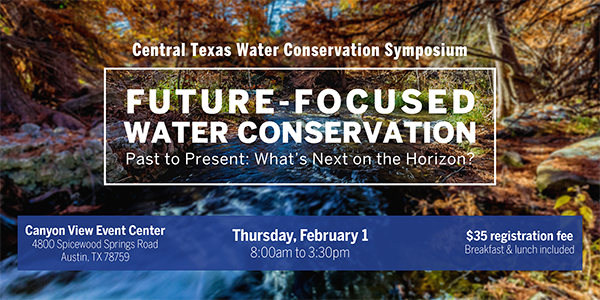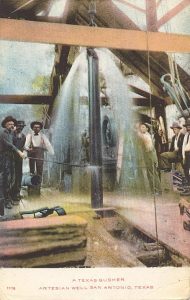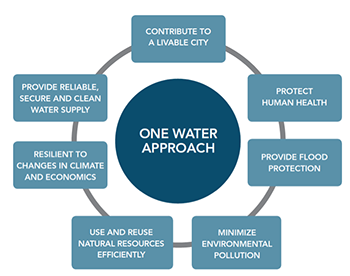The 8th annual Central Texas Water Conservation Symposium occurred on February 1, 2018 in Austin, Texas. The program included many great topics and interesting speakers. The title for this year’s Symposium was “Future Focused Water Conservation, Past to Present: What’s Next on the Horizon?” The Symposium provides the water industry with the information needed to implement successful water conservation programs, effectively engage customers, and plan for the future. The Symposium is always a great time to connect and reconnect with water professionals who are actively working to improve water conservation and efficiency in central Texas.
Presentations topics and speakers included:
- The Present & Future of Residential Water Efficiency by Ronald Voglewede, Globals Sustainability Director, Whirlpool Corporation
- Texas Legislative Changes Affecting Water Conservation by John Sutton, Manager of Water & ICI Water Conservation of the Texas Water Development Board
- Reducing Long-term Rate Impacts through Water Conservation & Lessons Learned from Water Conservation Program Design & Implementation by Candice Rupprecht, Water Conservation Manager, Tucson Water
- How the Great Artesian Depletion Taught Texas to Not Waste Water by Robert Mace, Chief Water Policy Officer, The Meadows Center for Water and the Environment
- PACE Financing for Water Efficiency in the Commercial & Institutional Sector by Jonathon Blackburn, Managing Director, Texas PACE Authority
- What is Integrated Urban Water Management or “One Water” & What Can It Do for Texas? by Sarah Richards, Water Program Officer, The Cynthia and George Mitchell Foundation
- How does Texas Measure Up? Comparing Laws & Regulations Enacted in the 50 States by Mary Ann Dickinson, President and CEO of the Alliance for Water Efficiency
Download the Central Texas Water Symposium program.
The slides from the presentations are available at the bottom of this post.
5 Inspiring Takeaways from the Symposium
1. The Water Conserving Appliance Innovations by the Whirlpool Corporation
 The Whirlpool Corporation has been actively reducing the water and energy use of their products since the late 1960s. Early on, they recognized that their appliances would be responsible for most of the energy and water use in our homes. Some of the interesting innovations that will be coming out soon is a new heat pump dryer, a water recycling dishwashing machine, as well as a in-home composter. In addition, they actively research how their appliances make an impact on energy and water use in a residential home by sponsoring the ReneWWW House.
The Whirlpool Corporation has been actively reducing the water and energy use of their products since the late 1960s. Early on, they recognized that their appliances would be responsible for most of the energy and water use in our homes. Some of the interesting innovations that will be coming out soon is a new heat pump dryer, a water recycling dishwashing machine, as well as a in-home composter. In addition, they actively research how their appliances make an impact on energy and water use in a residential home by sponsoring the ReneWWW House.
Robert Mace wrote a great blog post summarizing the innovations presented by Mr. Voglewede in his presentation.
2. The Amazing History of Artesian Wells in Texas and How it Changed the Path of Water Resource Development in Texas
Between the 1880s to 1910s, the artesian well drilling craze hit Texas. When this water “magically” bubbled to the surface, the assumption was that these wells would produce an “infinite” amount of water.
Did you know that when Fort Worth drilled their first artesian well in 1891, it produced so much water that the mayor called for “a well drilled at every corner”? In Waco, one of their wells was 1,800 feet deep and had an output of 1.5 million gallons of water per day!
It was common to just leave these artesian wells to run… constantly. In the 1920s, many artesian wells stopped producing water. Finally, in 1931, the Texas Legislature passed a law requiring wells to be turned off when not in use.
From the experience with the frenzied drilling of artesian wells in the early part of the 1900s, Texas started to learn the hard lessons that groundwater wasn’t an infinite source of future and that no water resource can be taken for granted.
3. PACE Financing Can be a Great Opportunity for Existing Commercial Developments to Implement Large-Scale Water Conservation Efforts
Property Assessed Clean Energy (PACE) is a proven financial tool that incentivizes Texas’ commercial, industrial, and multifamily property owners to upgrade existing facility infrastructure with little or no capital outlay. Approved by State legislation and established by local governments, PACE programs enable owners to lower their operating costs and use the savings to pay for eligible water conservation, energy efficiency, resiliency, and distributed generation projects.
PACE financing may be used to pay for permanent improvements to the property that are intended to decrease water or energy consumption or demand. In terms of the water conservation and efficiency improvements, PACE financing can be used for water heating systems, water management systems and controls, irrigation equipment, rainwater collection systems, toilets and other water fixtures, graywater reuse systems, and more.
4. How “One Water” or Integrated Urban Water Management can Bring Innovation to the Traditional Water Utility and Management Sectors
When you think about water, you most likely think about it in a very compartmentalized way. You have the water that you interact with in your home, both the potable supply you receive from the city and the wastewater that you send back to the city. Then you have the water in our environment such as the lakes and rivers in our state. You may even think about the water flowing through our communities during flood events. While it is easy to separate them, all of this water is ultimately the same water.
You are not alone though. This compartmentalized philosophy permeates all of our water management structures, from city departments to county planning agencies, to even the Texas Commission on Environmental Quality.
So it was refreshing to hear about the “One Water” concept that the Mitchell Foundation Water Program is promoting in order to change this compartmentalized water resource management paradigm.
One Water, as defined by the Water Research Foundation, is the integrated planning and implementation approach to managing finite water resources for long-term resilience and reliability, meeting both community and ecosystem needs. It requires us to think about water as a single system rather than disparate flows.
As the first step in their endeavor, the Mitchell Foundation has produced a report entitled “Advancing One Water in Texas” and it will be available soon. The report outlines the premise of One Water, the reasons why the shift needs to be made in Texas, potential obstacles to its adoption in Texas, and various action areas.
5. Tucson, Arizona, Performed an Avoided Cost Analysis to Quantify What Their Water Customers Would be Paying Without Their Water Conservation Efforts
I know you have probably asked this question before… “If we are doing a great job at conserving water and reducing our water consumption, why does my water rates continue to rise?” Well, many Tucson residents were asking the same question. Tucson Water had a scripted answer for their customers. Basically, “It’s complicated and there is a lot that contributes to water rates in our community.” That answer didn’t sit well with their customers so Tucson Water decided to quantify what their customers would be paying currently if the residents of Tucson hadn’t heeded the calls for water conservation back in the late 1980s.
Tucson Water developed an “avoided cost” analysis. They started with the population of Tucson in 1989 and that associated gallons per capita per day (gpcd) water usage. They applied the 1989 gpcd to the population of Tucson in 2015. This provided them with the amount of additional water per day that the city would have had to produce if Tucson residents were using the same gpcd in 2015 as they were in 1989. Then, they put a cost on all of the water infrastructure they would have had to construct in order to meet this higher demand for water.
What they figured out is that, by conserving water, the average water bill would be 12% higher today if the residents of Tucson were using water at the per capita rate of 1989. This equates to about $112 savings in the analysis year of 2015. While the $112 may not seem like a lot of money, it is real savings that were documented due to the practice of water conservation by the residents of Tucson. Also, remember that any infrastructure installed becomes a liability that has to be maintained. By not installing or delaying the installation to a later time when the produced water is needed, they are also removing liabilities from the city and ultimately the taxpayers.
Symposium Presentations
About the Central Texas Water Efficiency Network
The Central Texas Water Efficiency Network (CTWEN) is a coalition of municipalities, water providers, and water conservation advocates in the Central Texas region. Our purpose has been defined as the following: To openly and actively share information and promote water efficiency education, legislation, programs, technologies, and all other integral components of water conservation in order to regionally have an impact on water supplies and use.
CTWEN meets regularly on the second Thursday of each month. For additional information about CTWEN and upcoming meeting schedule, contact Jessica Woods, the City of Round Rock Water Conservation Coordinator.
Like this Review Post?
Comment below with your thoughts or questions. Thanks!








